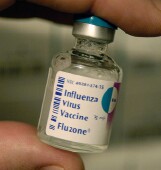
THURSDAY, Oct. 21 (HealthDay News) — As another flu season approaches, with the memory of last season’s H1N1 pandemic flu still fresh in the minds of many, scientists gathered Thursday to present the latest research on the flu virus and attempts to vaccinate against it.
“A year ago, everyone was focused on influenza and thought many of the important issues were answered, but anyone who knows the field knows that we continue to make advances,” said Dr. Andrew Pavia, chief of pediatric infectious diseases at the University of Utah and chairman of a Pandemic Influenza Task Force for the Infectious Diseases Society of America.
Among the advances, which are to be presented during the society’s annual meeting this week in Vancouver:
- Children who lived with nonsmokers and household members who had been vaccinated against the flu were less likely to become infected themselves. Those more likely to become infected were people with lower incomes, people who were behind on the usual schedule of childhood immunizations and children with certain underlying medical conditions such as asthma, cancer and some neurological disorders, report researchers from the New York University School of Medicine.
- Many more pregnant women got vaccinated for H1N1 last year than during a typical flu season. Women who were older, more educated, had received the flu vaccine during past pregnancies and who also got the regular flu vaccine were more likely to get inoculated. Also, “if obstetrical providers and public health authorities make a concerted effort to educate patients, patients are indeed willing to be vaccinated,” said Dr. Marci Drees, medical director of infection control at Christiana Care Health System in Newark, Del., and one of the conference presenters.
- Pregnant women who did choose to have the 2009 H1N1 vaccine were not more likely to have had fever or such short-term side effects as headache, nausea and muscle aches than were women who didn’t get vaccinated. “Our study of more than 750 pregnant women did not find any serious short-term complications after H1N1 vaccination,” said Stephanie Irving, an epidemiologist with the Marshfield Clinic Research Foundation in Marshfield, Wisc., and another conference presenter.
- “Neurological complications [such as encephalopathy and febrile seizures] related to H1N1 influenza were not as severe as anticipated, although they certainly did occur and they are important . . . and fatalities did occur,” said Dr. Carol Glaser, chief of epidemiology and the special investigation section in the Communicable Diseases and Emergency Response Branch of the California Department of Public Health. For unknown reasons, Asians were at higher risk for such complications.
Mandatory influenza vaccination programs were looked at in three studies for which abstracts were to be presented at the conference:
- One found that a mandatory program at Children’s Hospital of Philadelphia had high rates of coverage (upwards of 90 percent), but researchers found that almost three-fourths of the employees surveyed thought the policy was “coercive,” even though more than 90 percent “felt it was important for protecting patients and staff and that it was an important part of the job’s ethical responsibility,” said Dr. Kristen Feemster, an assistant professor at the University of Pennsylvania School of Medicine in Philadelphia.
- Another reported that few employees protested a mandatory vaccination program in Omaha, Neb., perhaps because administrators had “worked with employees to engage them to respond to their concerns and had worked to educate them,” said Dr. Archana Chatterjee, chief of pediatric infectious diseases at Creighton University School of Medicine. The program resulted in an immunization rate of 97 percent.
- Another mandatory program, this one at Children’s Hospital and Medical Center in Omaha, pushed vaccination rates up to 97.6 percent in 2005 and to more than 98 percent for the next four years. “Mandatory vaccination programs protect patients, protect health-care workers and their families and may reduce absenteeism and enable better staffing during flu season,” said Dr. Robert Rakita, a clinical professor of medicine, allergy and infectious diseases at the University of Washington, Seattle. “Our hope is that similar programs will become the standard of practice across the medical field.”
More information
The U.S. Centers for Disease Control and Prevention has more on H1N1.

